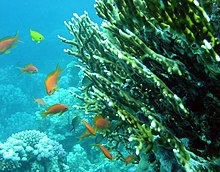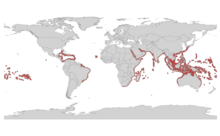Fire coral
| Fire coral | |
|---|---|
 |
|
| Millepora dichotoma | |
| Scientific classification | |
| Kingdom: | Animalia |
| Phylum: | Cnidaria |
| Class: | Hydrozoa |
| Order: | Anthomedusae |
| Suborder: | Capitata |
| Family: |
Milleporidae Fleming, 1828 |
| Genus: |
Millepora Linnaeus, 1758 |
| Diversity | |
| About one dozen species | |
 |
|
| Fire coral range | |
| Synonyms | |
|
Milleporadae (lapsus) |
|
Milleporadae (lapsus)
Fire corals are colonial marine organisms that exhibit physical characteristics similar to that of coral. The name coral is somewhat misleading, as fire corals are not actually true corals but are more closely related to Hydra and other hydrozoans, making them hydrocorals. They are members of the phylum Cnidaria, class Hydrozoa, order Capitata, family Milleporidae.
Fire corals have a bright yellow-green and brown skeletal covering and are widely distributed in tropical and subtropical waters. They appear in small brush-like growths on rocks and coral. Divers often mistake fire coral for seaweed, and accidental contact is common. Upon contact, an intense pain can be felt that can last from two days to two weeks. The very small on fire corals contain tentacles that protrude from numerous surface pores (similar to jellyfish stings). In addition, fire corals have a sharp, calcified external skeleton that can scrape the skin.
Fire coral has several common growth forms; these include branching, plate, and encrusting. Branching adopts a calcerious structure which branches off, to rounded, finger-like tips. Plate growth adopts a shape similar to that of the smaller nonsheet lettuce corals - erect, thin sheets, which group together to form a colony. In encrusting growth, the fire coral forms on the calcerious structure of other coral or gorgonian structures.
The gonophores in the family Milleporidae arise from the coenosarc (the hollow living tubes of the upright branching individuals of a colony) within chambers embedded entirely in the coenosteum (the calcareous mass forming the skeleton of a compound coral).
Fire corals are found on reefs in the Indian, Pacific, and Atlantic Oceans and the Caribbean Sea. They form extensive outcrops on projecting parts of the reef where the tidal currents are strong. They are also abundant on upper reef slopes and in lagoons, and occur down to 40 m deep.
The polyps of fire corals are near microscopic size and are mostly embedded in the skeleton and connected by a network of minute canals. All that is visible on the smooth surface are pores of two sizes: gastropores and dactylopores. In fact, Millepora means ‘thousand pores’. Dactylozooids have long fine hairs that protrude from the skeleton. The hairs possess clusters of stinging cells and capture prey, which is then engulfed by gastrozooids, or feeding polyps, situated within the gastropores. As well as capturing prey, fire corals gain nutrients via their special symbiotic relationship with algae known as zooxanthellae. The zooxanthellae live inside the tissues of the coral, and provide the coral with food, which they produce through photosynthesis, so require sunlight. In return, the coral provides the algae with protection and access to sunlight.
...
Wikipedia
